Popular categories
Looking for a yarn?

100% Wool
from 2.65 $ /50g
The yarn cost is calculated from the pattern’s smallest size and the yarn’s cheapest product type. Looking for an even better price? You might find it on the DROPS Deals!
Cozy Cuddle
Crochet set of striped jacket and slippers in DROPS Snow. Sizes baby and children from 1 month to 4 years.
FINISHED SIZE
1/3 – 6/9 – 12/18 months (2 –3/4 years)
FINISHED GARMENT MEASUREMENTS
Width at chest: 20½-22¾-26¾ (28 3/8-30¾) inches
Full length: 11¾-13-14¼ (15¾-17¾) inches
MATERIALS
DROPS Snow from Garnstudio
JACKET:
3-4-4 (5-5) balls #01, off-white
1-1-1 (2-2) balls #31, light mint
1-1-1 (2-2) balls #37, mint-mix
1 ball for all sizes of following colors: #13 camel, #23 dark beige, #30 baby pink, #36 rose-mix.
Size M/13/9 mm crochet hook or size needed to obtain gauge.
DROPS wooden button no 512: 4-4-4 (5-5) pcs
BOOTIES:
2-2-2 (2-2) balls #01, off-white
Size K/10½/7 mm crochet hook or size needed to obtain gauge.
-------------------------------------------------------
Alternative Yarn – See how to change yarns here
Yarn Groups A to F – Use the same pattern and change the yarn here
Yarn usage using an alternative yarn – Use our yarn converter here
-------------------------------------------------------

100% Wool
from 2.65 $ /50g
The yarn cost is calculated from the pattern’s smallest size and the yarn’s cheapest product type. Looking for an even better price? You might find it on the DROPS Deals!
- English (US/in)
- Česky - not translated
- Dansk
- Deutsch
- Eesti keel
- English (UK/cm)
- Español
- Français
- Íslenska
- Italiano
- Magyar
- Nederlands
- Norsk
- Polski
- Português
- Suomi
- Svenska
- English (UK/cm), Bulgaria
- English (UK/cm), Croatia
- English (UK/cm), Greece
- English (UK/cm), Latvia
- English (UK/cm), Lithuania
- English (UK/cm), Romania
- English (UK/cm), Slovenia
- Česky, Slovakia - not translated
Pattern instructions
GAUGE
Width of 4 dc-groups and 4 rows in height = 4 x 4 inches
STRIPES
See rows below - or chart 1 for right size.
Each row = 1 row of dc’s.
1/3+6/9 months: work row 2-13 below.
12/18 months: work row 1-13 below.
2 years: work row 2-17 below.
3/4 years: work row 1-17 below.
1st row: off white
2nd row: off white
3rd row: camel
4th row: light mint
5th row: mint-mix
6th row: rose-mix
7th row: baby pink
8th row: off white
9th row: camel
10th row: dark beige
11th row: mint-mix
12th row: light mint
13th row: off white
14th row: baby pink
15th row: rose-mix
16th row: camel
17th row: off white
CROCHET INFO 1
At the beginning of each row of dc’s replace the 1st dc with 3 ch, and finish each row with 1 dc in 3rd ch from beginning of previous row.
CROCHET INFO 2
1 dc-group = 2 dc in same st. ½ dc-group = 3 ch (equals 1 dc)
BACK PIECE
Read Crochet info 1.
With Snow #01, ch 31-34-40 (43-46).
Crochet stripes as described above as follows:
1st row: 1 dc in 4th ch from hook, *skip 2 ch, 2 dc in next ch*, repeat from *-* = 10-11-13 (14-15) dc-groups on row, turn the piece.
2nd row: 3 ch (= 1 dc), 2 dc between the first 2 dc-groups from previous row (crochet at top of st and not round the whole st), *2 dc between the next 2 dc-groups*, repeat from *-* and finish with 2 dc at the top of the last dc = 1 dc (3 ch) + 10-11-13 (14-15) dc-groups on row – read Crochet info 2. Repeat 2nd row.
When piece measures approx 8"-9"-9" (10⅝"-11¾") cast on new sts for sleeves each side as follows: Cut the yarn. Ch 16-19-19 (25-28), crochet as before over back piece, at the end of row ch 16-19-19 (25-28). Turn the piece and crochet as explained for 1st row so that the pattern continues as before = 1 dc (3 ch) + 20-23-25 (30-33) dc-groups on row.
When piece measures 11¾"-13"-14¼" (15¾"-17¾") fasten off.
LEFT FRONT PIECE
With Snow #01, ch 16-16-19 (22-22).
Crochet following explanation for stripes above and dc-groups as described for back piece = 1 dc (3 ch) +5-5-6 (7-7) dc-groups after 2nd row. When piece measures approx 8"-9"-9" (10⅝"-11¾") cast on new sts for sleeve at side as described for back piece. Continue pattern as before = 1 dc (3 ch) + 10-11-12 (15-16) dc-groups on row. When piece measures 11¾"-13"-14¼" (15¾"-17¾") fasten off.
RIGHT FRONT PIECE
Crochet as left front piece, but mirrored.
CUFFS
With Snow #01 crochet 2 rows of dc along sleeve edge = approx 1 dc (3 ch) + 8-8-10 (10-11) dc on row.
FRONT EDGES
With Snow #01 crochet 1 row of dc-groups along the front edge of both front pieces = approx 12-13-14 (16-18) dc-groups.
ASSEMBLY
Sew shoulder/sleeve seams – start at sleeve edge and work towards neckline – leave 5-5 dc-groups mid back for neck opening. Sew underarm and side seams.
HOOD
With Snow #01 crochet 1 sc in 1st st, ch 3, then approx 13-14-15 (16-17) dc-groups around neckline as described on 1sr row for jacket. Continue with dc-groups until hood measures approx 8¾"-9½"-10¼" (11½"-11¾"), fasten off. Fold hood double and sew top seam with neat sts.
BUTTONS
Sew on buttons on left front piece – the top one approx ½"-¾" from neckline and the bottom one approx 4"-4¾" from lower edge.
___________________________________________________________________________
BOOTIES:
To fit foot length: 4-4½-4¾ (5½-6) inches
GAUGE
Width of 10 sc and 11 rows in height = 4 x 4 inches.
CROCHET INFO
At the beginning of each row of sc’s replace the 1st sc with 1 ch, and finish each row with 1 sc in ch from beginning of previous row.
BOOTIE
Crochet the bootie in one piece and sew seams mid front and mid back.
With Snow #01, ch 7-8-9 (10-11). Crochet back and forth with sc - read Crochet Info – start in 2nd ch from hook. = 7-8-9 (10-11) sc on row. When piece measures 2¾"-3⅛"-3½" (4"-4") inc at one side for foot by ch 3-3-3 (4-4), turn and continue with sc in all sts = 10-11-12 (14-15) sc. When piece measures 6"-7"-8¼" (9½"-10¼") bind off the 3-3-3 (4-4) foot sts by turning the piece just before these sts. Continue with sc over the remaining 7-8-9 (10-11) sc until piece measures 8¾"-10¼"-11¾" (13⅜"-14¼"). Fasten off
ASSEMBLY
Fold bootie double and sew seam mid back and mid front with neat sts – leave an opening of approx 2"-2½"-2¾" (3"-3⅛") at the top mid front.
Crochet the other bootie.
POMPOM
Make 2 small pompons with a diameter of approx 1 inch and attach to top of each bootie.
___________________________________________________________________________
BLANKET
See pattern b14-21
This pattern has been corrected. Click here to see the correction/s.
When piece measures approx 8”-9”-9” (10 5/8”-11¾”) cast on new sts for sleeves each side as follows: Cut the yarn. Ch 16-19-19 (25-28), crochet as before over back piece, at the end of row ch 16-19-19 (25-28). Turn the piece and crochet as explained for 1st row so that the pattern continues as before = 1 dc (3 ch) + 20-23-25 (30-33) dc-groups on row.
Diagram
All measurements in charts are in cm.

|
= off-white |

|
= camel |

|
= light mint |

|
= mint mix |

|
= rose mix |

|
= baby pink |

|
= dark beige |
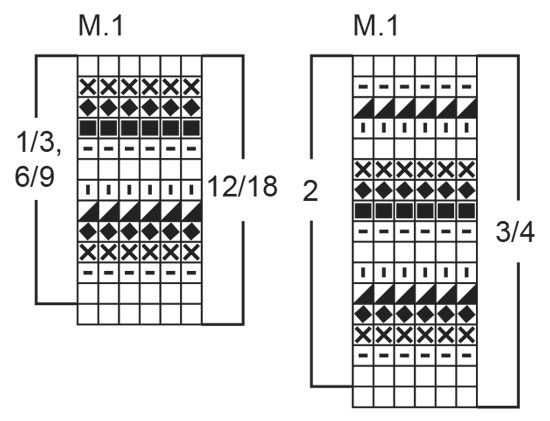

What can you do with our patterns? You can share DROPS patterns online, using the pattern original picture, materials, name and number. But you are NOT ALLOWED to reproduce the complete pattern digitally in any way. Yarn stores are welcome to use the DROPS pattern database to promote the sale of our assortment. You can print out our patterns, make as many copies as you’d like. The only thing we ask is that you don't make any changes / additions to the original printed document. And that the patterns according to the DROPS philosophy are given out to the consumers for free. Editorials that wish to publish our patterns in printed books or magazines can contact us for more information. The sale of garments based on DROPS patterns is permitted as long as they are sold as single items or per order. Further commercial use of the patterns is not permitted. It has to be clearly stated that the garment is made based on a design from DROPS DESIGN. The use of clothing labels of which DROPS DESIGN forms part is conditioned by the inclusion of the following text: “A DROPS DESIGN made by …..”. The use of DROPS photos for marketing purposes/sales is only permitted in connection with the use/sale of DROPS products. The photos may not be cut or edited and the logo should be clearly visible.
We reserve the right to withdraw the permission for use of our patterns at any time, notwithstanding the reason.
Each of our patterns has specific tutorial videos to help you.
These step-by-step tutorials might also help you:
Why is the knitting/crochet tension so important?
Knitting tension is what determines the final measurements of your work, and is usually measured per 10 x 10 cm. It is provided like so: number of stitches in width x number of rows in height - eg: 19 stitches x 26 rows = 10 x 10 cm.
The knitting tension is very individual; some people knit/crochet loosely while others work tightly. You adjust the knitting tension with the needle size, which is why the suggested needle size only serve as a guide! You need to adjust this (up or down) to ensure that YOUR knitting tension matches the knitting tension provided in the pattern. If you work with a different knitting tension than provided you will have a different yarn consumption, and your work will have different measurements than what the pattern suggests.
The knitting tension also determines which yarns can replace each other. As long as you achieve the same knitting tension you can replace one yarn with another.
See DROPS lesson: How to measure your tension/gauge
See DROPS video: How to make a gauge tension swatch
How do I know how many balls of yarn I need?
The required amount of yarn is provided in grams, eg: 450 g. To calculate how many balls you’ll need you first need to know how many grams are in 1 ball (25g, 50g or 100g). This information is available if you click on the individual yarn quality on our pages. Divide the amount required with the amount of each ball. For example, if each ball is 50g (the most common amount), the calculation will be as follows: 450 / 50 = 9 balls.
Can I use a different yarn than what the pattern suggests?
The important thing when changing from one yarn to another is that the knitting/crochet tension remains the same. This is so that the measurements of the finished piece will be the same as on the sketch provided. It is easier to achieve the same knitting tension using yarns from the same yarn group. It is also possible to work with multiple strands of a thinner yarn to achieve the knitting tension of a thicker one. Please try our yarn converter. We recommend you to always work a test swatch.
Please NOTE: when changing yarn the garment might have a different look and feel to the garment in the photo, due to individual properties and qualities of each yarn.
See DROPS lesson: Can I use a different yarn than the one mentioned in the pattern?
What are the yarn groups?
All our yarns are categorised into yarn groups (from A to F) according to thickness and knitting tension – group A contains the thinnest yarns and group F the thickest. This makes it easier for you to find alternative yarns to our patterns, should you wish to switch yarn. All yarns within the same group have a similar knitting tension and can easily replace each other. However, different yarn qualities have different structures and properties which will give the finished work a unique look and feel.
How do I use the yarn converter?
At the top of all our patterns you’ll find a link to our yarn converter, which is a helpful tool should you wish to use a different yarn than suggested. By filling in the yarn quality you wish to replace, the amount (in your size) and number of strands, the converter will present good alternative yarns with the same knitting tension. Additionally it will tell you how much you’ll require in the new qualities and whether you’ll need to work with multiple strands. Most skeins are 50g (some are 25g or 100g).
If the pattern is worked with multiple colours, every colour will have to be converted separately. Similarly, if the pattern is worked with several strands of different yarns (for example 1 strand Alpaca and 1 strand Kid-Silk) you will have to find alternatives for each, individually.
Why do you show discontinued yarns in the patterns?
Since different yarns have different qualities and textures we have chosen to keep the original yarn in our patterns. However, you can easily find options among our available qualities by using our yarn converter, or simply pick a yarn from the same yarn group.
It is possible that some retailers still have discontinued yarns in stock, or that someone has a few skeins at home that they would like to find patterns for.
The yarn converter will provide both alternative yarn as well as required amount in the new quality.
What size should I knit?
If you think it's hard to decide what size to make, it can be a good idea to measure a garment you own already and like the size of. Then you can pick the size by comparing those measures with the ones available in the pattern's size chart.
You'll find the size chart at the bottom of the pattern.
See DROPS lesson: How to read size chart
Why do I get the wrong knitting tension with the suggested needle size?
The needle size provided in the pattern serves only as a guide, the important thing is to follow the knitting tension. And since knitting tension is very individual, you will have to adjust the needle size to ensure that YOUR tension is the same as in the pattern – maybe you’ll have to adjust 1, or even 2 needle sizes, up or down to achieve the correct tension. For this, we recommend that you work test swatches.
Should you work with a different knitting tension than the one provided, the measurements of the finished garment might deviate from the measurement sketch.
See DROPS lesson: How to measure your tension/gauge
See DROPS video: How to make a gauge tension swatch
Why is the pattern worked top-down?
Working a garment top-down provides more flexibility and room for personal adjustment. For example it is easier to try the garment on while working, as well as making adjustments to length of yoke and shoulder caps.
The instructions are carefully explaining every step, in the correct order. Diagrams are adjusted to the knitting direction and are worked as usual.
How do I work according to a knitting diagram?
The diagram depicts all rows/rounds, and every stitch seen from the right side. It is read from bottom to top, from right to left. 1 square = 1 stitch.
When working back and forth, every other row is worked from the right side and every other row is worked from the wrong side. When working from the wrong side, the diagram will have to be worked reversed: from left to right, knit stitches are purled, purl stitches are knit etc.
When working in the round every round is worked from the right side and the diagram are worked from right to left on all rounds.
See DROPS lesson: How to read knitting diagrams
How do I work according to a crochet diagram?
The diagram depicts all rows/rounds, and every stitch seen from the right side. It is worked from bottom to top, from right to left.
When working back and forth every other row is worked from the right side: from right to left and every other row is worked from the wrong side: from left to right.
When working in the round, every row in the diagram are worked from the right side, from right to left.
When working a circular diagram you start in the middle and work your way outwards, counter clockwise, row by row.
The rows usually start with a given number of chain stitches (equivalent to the height of the following stitch), this will either be depicted in the diagram or explained in the pattern.
See DROPS lesson: How to read crochet diagrams
How do I work several diagrams simultaneously on the same row/round?
Instructions for working several diagrams after each other on the same row/round, will often be written like so: “work A.1, A.2, A.3 a total of 0-0-2-3-4 times". This means you work A.1 once, then A.2 is worked once, and A.3 is repeated (in width) the number of times provided for your size – in this case like so: S = 0 times, M = 0 times, L=2 times, XL= 3 times and XXL = 4 times.
The diagrams are worked as usual: begin with the first row in A.1, then work the first row in A.2 etc.
See DROPS lesson: How to read knitting diagrams
See DROPS lesson: How to read crochet diagrams
Why are the sleeves shorter in larger sizes?
The total width of the garment (from wrist-to-wrist) will be larger in the larger sizes, despite the actual sleeves being shorter. The larger sizes have longer sleeve caps and wider shoulders, so there will be a good fit in all sizes.
Where on the garment is the length measured?
The measurement sketch/schematic drawing provides information regarding the full length of the garment. If it’s a jumper or a jacket the length is measured from the highest point on the shoulder (usually closest to the neckline), and straight down to the bottom of the garment. It is NOT measured from the tip of shoulder. Similarly, the length of yoke is measured from the highest point on the shoulder and down to where yoke is split into body and sleeves.
See DROPS lesson: How to read a schematic drawing
What is a repeat?
Diagrams are often repeated on the round or in height. 1 repeat is the diagram the way it appears in the pattern. If it says to work 5 repeats of A.1 in the round, then you work A.1 a total of 5 times after/next to each other in the round. If it says to work 2 repeats of A.1 vertically/in height you work the entire diagram once, then begin again at the start and work the entire diagram one more time.
Why does the piece start with more chain stitches than it’s worked with?
Chain stitches are slightly narrower than other stitches and to avoid working the cast-on edge too tight, we simply chain more stitches to begin with. The stitch count will be adjusted on the following row to fit the pattern and measurement sketch.
Why increase before the rib edge when the piece is worked top-down?
The rib edge is more elastic and will contract slightly compared to, for example, stocking stitch. By increasing before the rib edge, you avoid a visible difference in width between the rib edge and the rest of the body.
Why increase in the cast-off edge?
It’s very easy to cast off too tightly, and by making yarn overs while casting off (and simultaneously casting these off) you avoid a too tight cast off edge.
See DROPS video: How to bind off with yarn overs (yo)
How do I increase/decrease on every 3rd and 4th row/round alternately?
To achieve an even increase (or decrease) you can increase on, for example: every 3rd and 4th row alternately, like so: work 2 rows and increase on the 3rd row, work 3 rows and increase on the 4th. Repeat this until the increase is complete.
See DROPS lesson: Increase or decrease 1 st on every 3rd and 4th row alternately
How can I work a jacket in the round instead of back and forth?
Should you prefer to work in the round instead of back and forth, you may of course adjust the pattern. You’ll need to add steeks mid-front (usually 5 stitches), and follow the instructions. When you would normally turn and work from the wrong side, simply work across the steek and continue in the round. At the end you’ll cut the piece open, pick up stitches to work bands, and cover the cut edges.
See DROPS video: How to knit steeks and cut open
Can I work a jumper back and forth instead of in the round?
Should you prefer to work back and forth instead of in the round, you may of course adjust the pattern so you work the pieces separately and then assemble them at the end. Divide the stitches for the body in 2, add 1 edge stitch in each side (for sewing) and work the front and back pieces separately.
See DROPS lesson: Can I adapt a pattern for circular needles into straight needles?
Why is the pattern slightly different than what I see in the photo?
Pattern repeats can vary slightly in the different sizes, in order to get the correct proportions. If you’re not working the exact same size as the garment in the photo, yours might deviate slightly. This has been carefully developed and adjusted so that the complete impression of the garment is the same in all sizes.
Make sure to follow instructions and diagrams for your size!
How do I make a women’s size garment into a men’s size one?
If you have found a pattern you like which is available in women’s size it’s not very difficult to convert it to men’s size. The biggest difference will be the length of sleeves and body. Start working on the women size that you think would fit across the chest. The additional length will be worked right before you cast off for the armhole/sleeve cap. If the pattern is worked top-down you can add the length right after the armhole or before the first decrease on sleeve.
Regarding additional yarn amount, this will depend on how much length you add, but it is better with a skein too many than too few.
How do I prevent a hairy garment from shedding?
All yarns will have excess fibres (from production) that might come off as lint or shedding. Brushed yarns (ie hairier yarns) have more of these loose, excess fibres, causing more shedding.
Shedding also depends on what is worn under or over the garment, and whether this pulls at the yarn fibres. It’s therefore not possible to guarantee that there will be no shedding
Below are some tips on how to get the best result when working with hairier yarns:
1. When the garment is finished (before you wash it) shake it vigorously so the looser hairs come off. NOTE: do NOT use a lint roller, brush or any method that pulls at the yarn.
2. Place the garment in a plastic bag and put it in your freezer - the temperature will cause the fibres to become less attached to each other, and excess fibres will come off easier.
3. Leave in the freezer for a few hours before taking it out and shaking it again.
4. Wash the garment according to the instructions on the yarn label.
Why does my garment pill?
Pilling is a natural process that happens to even the most exclusive of fibers. It's a natural sign of wear and tear that is hard to avoid, and that is most visible in high friction areas of your garment like a sweater's arms and cuffs.
You can make your garment look as new by removing the pilling, using a fabric comb or a pill/lint remover.
In the meantime, you can read the questions and answers that others have left to this pattern or join the DROPS Workshop on Facebook to get help from fellow knitters/crocheters!
You might also like...
Cozy Cuddle |
||||||||||||||||||||||
 |
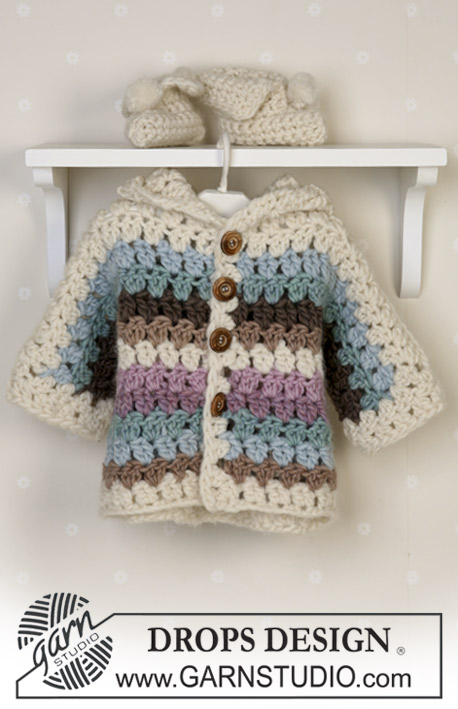 |
|||||||||||||||||||||
Crochet set of striped jacket and slippers in DROPS Snow. Sizes baby and children from 1 month to 4 years.
DROPS Baby 14-25 |
||||||||||||||||||||||
|
JACKET: GAUGE Width of 4 dc-groups and 4 rows in height = 4 x 4 inches STRIPES See rows below - or chart 1 for right size. Each row = 1 row of dc’s. 1/3+6/9 months: work row 2-13 below. 12/18 months: work row 1-13 below. 2 years: work row 2-17 below. 3/4 years: work row 1-17 below. 1st row: off white 2nd row: off white 3rd row: camel 4th row: light mint 5th row: mint-mix 6th row: rose-mix 7th row: baby pink 8th row: off white 9th row: camel 10th row: dark beige 11th row: mint-mix 12th row: light mint 13th row: off white 14th row: baby pink 15th row: rose-mix 16th row: camel 17th row: off white CROCHET INFO 1 At the beginning of each row of dc’s replace the 1st dc with 3 ch, and finish each row with 1 dc in 3rd ch from beginning of previous row. CROCHET INFO 2 1 dc-group = 2 dc in same st. ½ dc-group = 3 ch (equals 1 dc) BACK PIECE Read Crochet info 1. With Snow #01, ch 31-34-40 (43-46). Crochet stripes as described above as follows: 1st row: 1 dc in 4th ch from hook, *skip 2 ch, 2 dc in next ch*, repeat from *-* = 10-11-13 (14-15) dc-groups on row, turn the piece. 2nd row: 3 ch (= 1 dc), 2 dc between the first 2 dc-groups from previous row (crochet at top of st and not round the whole st), *2 dc between the next 2 dc-groups*, repeat from *-* and finish with 2 dc at the top of the last dc = 1 dc (3 ch) + 10-11-13 (14-15) dc-groups on row – read Crochet info 2. Repeat 2nd row. When piece measures approx 8"-9"-9" (10⅝"-11¾") cast on new sts for sleeves each side as follows: Cut the yarn. Ch 16-19-19 (25-28), crochet as before over back piece, at the end of row ch 16-19-19 (25-28). Turn the piece and crochet as explained for 1st row so that the pattern continues as before = 1 dc (3 ch) + 20-23-25 (30-33) dc-groups on row. When piece measures 11¾"-13"-14¼" (15¾"-17¾") fasten off. LEFT FRONT PIECE With Snow #01, ch 16-16-19 (22-22). Crochet following explanation for stripes above and dc-groups as described for back piece = 1 dc (3 ch) +5-5-6 (7-7) dc-groups after 2nd row. When piece measures approx 8"-9"-9" (10⅝"-11¾") cast on new sts for sleeve at side as described for back piece. Continue pattern as before = 1 dc (3 ch) + 10-11-12 (15-16) dc-groups on row. When piece measures 11¾"-13"-14¼" (15¾"-17¾") fasten off. RIGHT FRONT PIECE Crochet as left front piece, but mirrored. CUFFS With Snow #01 crochet 2 rows of dc along sleeve edge = approx 1 dc (3 ch) + 8-8-10 (10-11) dc on row. FRONT EDGES With Snow #01 crochet 1 row of dc-groups along the front edge of both front pieces = approx 12-13-14 (16-18) dc-groups. ASSEMBLY Sew shoulder/sleeve seams – start at sleeve edge and work towards neckline – leave 5-5 dc-groups mid back for neck opening. Sew underarm and side seams. HOOD With Snow #01 crochet 1 sc in 1st st, ch 3, then approx 13-14-15 (16-17) dc-groups around neckline as described on 1sr row for jacket. Continue with dc-groups until hood measures approx 8¾"-9½"-10¼" (11½"-11¾"), fasten off. Fold hood double and sew top seam with neat sts. BUTTONS Sew on buttons on left front piece – the top one approx ½"-¾" from neckline and the bottom one approx 4"-4¾" from lower edge. ___________________________________________________________________________ BOOTIES: To fit foot length: 4-4½-4¾ (5½-6) inches GAUGE Width of 10 sc and 11 rows in height = 4 x 4 inches. CROCHET INFO At the beginning of each row of sc’s replace the 1st sc with 1 ch, and finish each row with 1 sc in ch from beginning of previous row. BOOTIE Crochet the bootie in one piece and sew seams mid front and mid back. With Snow #01, ch 7-8-9 (10-11). Crochet back and forth with sc - read Crochet Info – start in 2nd ch from hook. = 7-8-9 (10-11) sc on row. When piece measures 2¾"-3⅛"-3½" (4"-4") inc at one side for foot by ch 3-3-3 (4-4), turn and continue with sc in all sts = 10-11-12 (14-15) sc. When piece measures 6"-7"-8¼" (9½"-10¼") bind off the 3-3-3 (4-4) foot sts by turning the piece just before these sts. Continue with sc over the remaining 7-8-9 (10-11) sc until piece measures 8¾"-10¼"-11¾" (13⅜"-14¼"). Fasten off ASSEMBLY Fold bootie double and sew seam mid back and mid front with neat sts – leave an opening of approx 2"-2½"-2¾" (3"-3⅛") at the top mid front. Crochet the other bootie. POMPOM Make 2 small pompons with a diameter of approx 1 inch and attach to top of each bootie. ___________________________________________________________________________ BLANKET See pattern b14-21 |
||||||||||||||||||||||
Diagram explanations |
||||||||||||||||||||||
|
||||||||||||||||||||||

|
||||||||||||||||||||||

|
||||||||||||||||||||||
|
Have you made this or any other of our designs? Tag your pictures in social media with #dropsdesign so we can see them! Do you need help with this pattern?You'll find tutorial videos, a Comments/Questions area and more by visiting the pattern on garnstudio.com. © 1982-2024 DROPS Design A/S. We reserve all rights. This document, including all its sub-sections, has copyrights. Read more about what you can do with our patterns at the bottom of each pattern on our site. |
||||||||||||||||||||||
With over 40 years in knitting and crochet design, DROPS Design offers one of the most extensive collections of free patterns on the internet - translated to 17 languages. As of today we count 304 catalogs and 11422 patterns - 11417 of which are translated into English (US/in).
We work hard to bring you the best knitting and crochet have to offer, inspiration and advice as well as great quality yarns at incredible prices! Would you like to use our patterns for other than personal use? You can read what you are allowed to do in the Copyright text at the bottom of all our patterns. Happy crafting!













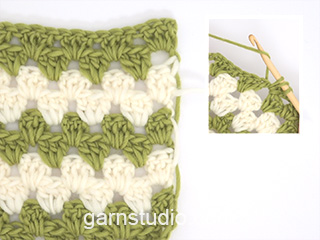
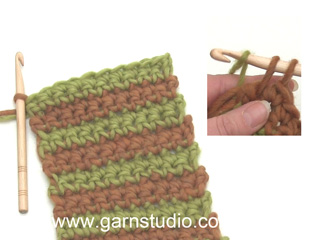
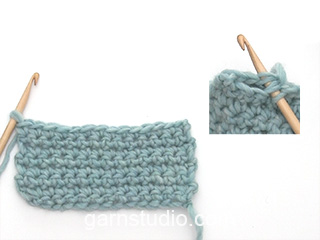
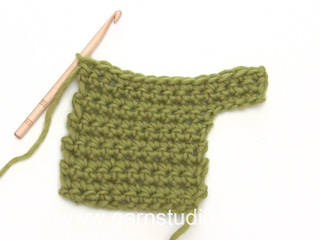











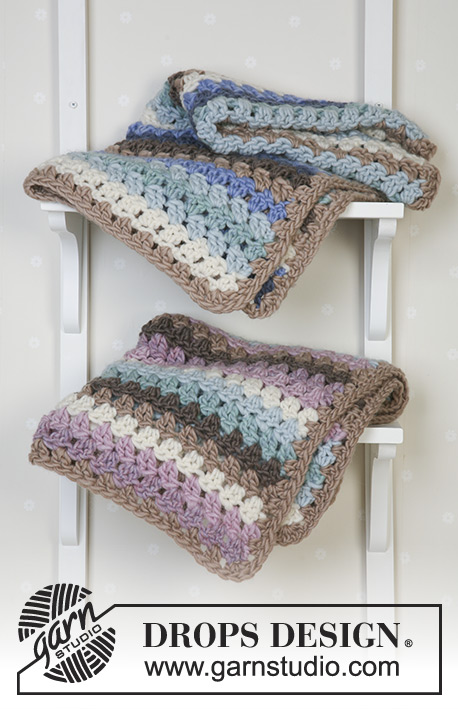







Comments / Questions (98)
Hei! Lurer litt på disse armene jeg også. Jeg forstår at jeg klipper tråden og starter med 19 luftmasker med ny tråd og \"fester\" disse med å fortsette med staver som vanlig i bakstykket over til andre siden der det avsluttes med 19 luftmasker... MEN... hvilken farge blir det nå? Dersom luftmaskene og rekken med staver er i én farge vil jo da neste rad få en tynn stripe med fargen fra forrige rad der armene starter.... Beklager dårlig forklaring :-)
07.03.2018 - 22:55I’m having difficulty understanding the yarn quantities required for the jacket. In simple terms, how many grams do I need of each colour please?
27.02.2018 - 23:04DROPS Design answered:
Dear Sue, the yarn quantities are given for the different sizes, so what you would need depends on which size you want to knit. For example if you want to knit the size for 56/9 months olf babies, that is the second in the list where we state the sizes. So take the second amount given for each color. Also do not forget, you can always ask for help in person in the store you bought (or buying) your DROPS yarn from. Happy Crafting!
27.02.2018 - 23:22Hola! Tengo una duda respecto a este patrón. Cuando acabo la ultima fila de la espalda, es decir, hago el ultimo punto alto y tengo 23 cm, entonces corto el hilo (aquí me surge la primera pregunta, debo rematar este punto?). A continuación, sin dar la vuelta, monto 19 cadenas y entonces, debo empezar a trabajar sobre esas 19 cadenas como si fuera la primera fila de la espalda, o las dejo sueltas y empiezo a trabajar sobre la espalda? Muchas gracias
09.01.2018 - 14:18DROPS Design answered:
Hola Tana, cuandos cortas el hilo SIEMPRE hay que rematar los puntos. Comenzamos montando 19 puntos de cadeneta. Ahora, continuamos trabajando la cadeneta; el punto 20 es el 1º punto de la espalda. Trabajamos todos los puntos de la espalda y al final montamos 19 puntos de cadeneta para la otra manga. Ahora continuamos trabajando de ida y vuelta sobre los puntos de la espalda y de las dos mangas.
13.01.2018 - 20:44Hej jag skulle vilja göra denna kofta till 12-åring med virknål 4. Hur gör jag om mönstret?
25.05.2017 - 13:37DROPS Design answered:
Hej, Vi kan tyvärr inte skriva om våra mönster, men du kanske kan välja en dam modell i Small som DROPS 97-1 och virka ärmarna kortare....
29.05.2017 - 14:24Merci pour votre reponse rapide.
01.03.2017 - 17:32Bonjour, pouvez vous me dire ce que veut dire ca 12 til 15 cm sur le schéma ? Merci
01.03.2017 - 16:50DROPS Design answered:
Bonjour Mme Rakotomanga, cela signifie environ 12 à 15 cm. Bon crochet!
01.03.2017 - 17:21Ik haak met andere wol (phildar partner6) dan het patroon. Ik vind er moeilijk om te werken met het aantal opzet steken omdat ik ander garen gebruik en dunnere haaknaald. Het rugpand is nu 40 cm breed, de lengte 23 cm tot aan de mouw staat wel keurig genoteerd en hou dit ook aan. Maar hoe lang moeten de mouwen worden in cm. Ik heb geen idee, heb zelf geen kinderen. En is 40 cm voor het rugpand niet te breed? Dit zijn 17 gr St en 2 1/2 stokjes. De lengte is 17 toeren.
18.12.2016 - 14:36DROPS Design answered:
Hoi Tania. Ik kan je helaas niet helpen bij individuele aanpassingen en andere garens. Maar onderaan het patroon vind je de maattekening voor elke maat in cm. Je kan hier vergelijken met je eigen werk en de maat die je gaat maken. Succes.
19.12.2016 - 16:04How many balls of eskimo would I need to do a plain version of crochet jacket and booties ? thank you
05.08.2016 - 16:44DROPS Design answered:
Dear Mrs Wiosna, best way would be to add the total amount of yarn in each colour for the desired size for 2 pieces. you may need somewhat less but maybe not that much less. Happy crocheting!
05.08.2016 - 17:13Can this pattern adjusted fo a 6 year old? Thank you!
21.09.2015 - 22:49DROPS Design answered:
Dear Diane, you can adapt this pattern to any other size with the help of measurement for the desired size. Please contact your DROPS store for any individual and personal assistance if required. Happy crocheting!
22.09.2015 - 10:52Mutsje: Ik heb er ook een mutsje bij gemaakt. Deze komt van de site steek-voor-steek.blogspot.nl. patroon voor een babymutsje gehaakt in de vd steek. Ik kan de link alleen niet neerzetten. ... Voor een New bron mutsje heb ik 8 stokjes met losse in de eerste ring gezet ipv 11 stokjes met losse. Verder is het patroon gewoon te volgen.
13.09.2015 - 09:05